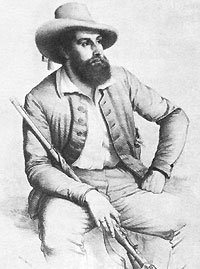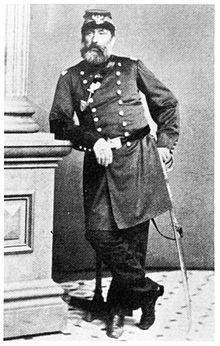Germain Metternich
Germain Franz Metternich (born April 5, 1811 in Mainz (then Mayence ), † May 13, 1862 on Tybee Island , Georgia ) was the son of Mainz university professor Mathias Metternich , one of the leading clubists and in 1793 Vice President of the Rhine-German National Convention . Metternich first embarked on a military career, but was involved in the democracy movement in southern Germany from the beginning of the 1830s . He took part in the Hambach Festival and later in the battles of the German Revolution of 1848/1849 in southern Germany. In 1850 he emigrated to the USA . There he belonged to the group of Forty-Eighters and was still politically active. When the Civil War broke out , he reported to the Union troops and was killed by a drunken soldier on a campaign in 1862.
Youth and military career
Germain Metternich was born in Mayence in the Département du Mont-Tonnerre in France at the time in 1811 . His father, Mathias Metternich, was one of the leading clubists in Mainz in 1792/1793. Metternich embarked on a military career in 1828 and joined the artillery in the army of the Grand Duchy of Hesse . Later he is said to have changed to the Hessian fourth infantry regiment in Offenbach, where he achieved the rank of lieutenant by 1832 . According to other sources, Metternich quit his service as a lieutenant in the Grand Ducal Dragoons .
Political activities before 1848
Metternich ended his military career in 1832 to become a man of letters and to join the democracy movement. In May 1832 he took part in the Hambach Festival together with the wine merchant Georg Strecker as head of the Mainz contingent of 400 Mainz citizens. On June 11, 1832, Metternich was again one of the organizers of the “Whitsun Festival on the Niederwald”, an event similar to the Hambach Festival in a political sense. Due to his political activities during this time, Metternich was arrested several times and served a three-year prison sentence at the Marksburg . After this period, Metternich fled to neighboring, neutral Switzerland for the first time . After his return to Mainz in 1847 he became a board member of the local gymnastics federation (the "Free Gymnastics Community"). The increasingly radicalized political gymnastics community in Mainz was, similar to the organized carnival around the Mainz Carneval Association , a politically and militarily very active group in the pre-March period .
Activities during the German Revolution 1848/1849
The first unrest of the German Revolution reached Mainz in the spring of 1848. A Mainz vigilante group quickly emerged under the command of the lawyer Franz Heinrich Zitz . Metternich was elected his adjutant. At the same time, Metternich headed a “gymnastics unit”, a paramilitary and partly armed unit with politically active members. At the end of April 1848 Metternich also joined the Mainz local group of the “ League of Communists ”. This was an early organization of the labor movement with its headquarters in Brussels, where Karl Marx was also staying at the time. When the “Democratic Association” was founded on May 11, 1848, he also joined it. At the first Democrats' Congress in the Free City of Frankfurt in June 1848, he was elected to the provisional central committee of the German Democrats, together with Franz Heinrich Zitz, and was politically considered a “radical democrat”.
When the fighting against Prussian troops broke out in Rheinhessen in May 1848, Metternich also took part on the part of the vigilante group. In the battle in the palace garden of Kirchheimbolanden , however, the revolutionaries' troops were defeated and Metternich fled abroad together with other leaders of the revolution such as Ludwig Bamberger , Ludwig Blenker and Franz Zitz. After he was involved in the September uprising in Frankfurt on September 17 and 18 , he had to go into hiding again, searched for in a wanted list. A "signalement" (profile), which was published in the Schleswig-Holstein advertisements on October 2, 1848, describes Metternich as follows: Signalement: 1) Germain Metternich from Mainz: age approx. 25 years, size very large, hair dark blond, eyes blue, eyebrows blond, nose curved, mouth proportioned, forehead high, beard dark blond and strong, chin overgrown, teeth healthy, face oval, complexion healthy, stature strong and slim. He returned to Germany during the imperial constitution campaign in 1849 and also took an active part in the Palatinate-Baden uprising. There he fought with Franz Sigel, among others . After the uprising was put down, he fled to Switzerland again. The following year there was a high treason trial against Metternich in Mainz. He was acquitted, but expelled from Germany. When Switzerland also expelled him shortly afterwards, Metternich emigrated to the USA.
Living in the United States
When Metternich emigrated to the United States in 1850, he settled in New York . There, too, he was involved in building a politically active gymnastics body. Under Metternich's significant influence, members of the gymnastics association, which was also founded by German immigrants in 1848, became the “Socialist Gymnastics Club of New York”. In the United States, Metternich belonged to the influential circle of the Forty-Eighters, after 1848/1849 German revolutionaries emigrated.
When the Civil War broke out in 1861, he immediately enlisted in the Northern Army. He served there in the 46th New York Regiment ("Forty-sixth New York Volunteers"), which was predominantly made up of German immigrants, under Colonel Rudolph Rosa , who was also of German descent, with the rank of Lieutenant Colonel. He was already involved with his regiment in the first battle at Bull Run . In the early summer of 1862 he was involved in military operations against Fort Pulaski , opposite the island of Tybee , that protected the Savannah River and the city of the same name in Georgia. When he was trying to settle a dispute among drunken soldiers there on May 13, 1862, a stumbling soldier rammed a bayonet through his neck. Metternich bled to death from this injury.
souvenir
On Tybee Island there is still a memorial stone erected at that time in honor of Metternich with the inscription “G. v. Metternich. Mainz 1811. Tybee 1862. “ . In New York, a lengthy obituary appeared in the German-language newspaper Demokrat on May 15, 1862. In the book of honor of the regiment to which Metternich belonged, the regimental chaplain, Dr. Winter, an obituary for him. Both obituaries praised Metternich as a “witty, insightful and well-educated man” , “whom his love for the people [...] drove into the ranks of fighters against the enemies of the republic” and “his worst opponents, the princes, the nobility and chased the priests out of the fatherland. "
reception
Metternich is usually only mentioned in his role as a campaigner of well-known personalities such as Struve, Zitz or Sigel when dealing with the history of the South German revolution of 1848/1849. In the context of his political activities he is referred to as a “radical democrat”, in American publications as a “professional revolutionary”. Franz Raveaux , one of the most famous German revolutionaries of the March Revolution of 1848/49, on the other hand, was critical of Germain Metternich:
“ He only knew how to answer incomprehensible things, and the stories that later circulated about Metternich clearly show that large water boots, a red feather on a floppy hat, a blouse and a terrible beard are not enough on their own to state a man's bravery. "
literature
- Richard Falck: Germain Metternich: A German freedom fighter, the last state prisoner of the Marksburg; A biography. Delivery: H. Krichtel, Mainz 1954.
- Walter Hell: The radical democrat Germain Metternich and the free-thinking Rheingau. in: Walter Hell: From the Mainz wheel to the Hessian lion. Sutton Verlag Erfurt, 2008. ISBN 978-3-86680-356-5 .
- Anton Maria Keim : Germain Metternich - from Mainz revolutionary to American Turner general. in: Lively Rhineland-Palatinate. Journal of Culture and History. Issue 13, 1976, pp. 86-88.
Web links
- Demokratiegeschichte.eu - Germain Metternich (1811–1862)
Individual evidence
- ^ Jörg Schweigard: Political gymnastics clubs in Germany 1817-1840. in: H. Reinalter (Ed.): Political associations, societies and parties in Central Europe 1815-1848 / 49. Frankfurt am Main 2005, pp. 51-77.
- ^ Schleswig-Holstein advertisements in 1848
- ^ Ansgar Reis: Radicalism and Exile: Gustav Struve and Democracy in Germany and America. P. 268
- ^ 46th Regiment, New York Volunteers
- ↑ quoted from Anton Maria Keim: Germain Metternich. From revolutionary in Mainz to American "Turner-General". , P. 86
- ^ So in Jonathan Sperber : Rhineland Radicals: The Democratic Movement and the Revolution of 1848-1849. Princeton University Press, 1992, S: 102
- ^ Franz Raveaux, Memoirs, quoted from: Deutsches Wochenblatt für constitutionelle Monarchie 1851, p. 58
Remarks
- ↑ The sources provide different information about birthday and year. April 10 is also given as the birthday and 1804 as the year of birth. An entry in a baptismal register, searchable via familysearch.org with the search term “Germain Metternich”, however, proves the baptism of a “Germannus Franciscus Metternich” on April 6, 1811 in Mainz Cathedral, so that April 5, 1811 was the birthday and - year seems the most plausible. ( Baptismal register )
| personal data | |
|---|---|
| SURNAME | Metternich, Germain |
| ALTERNATIVE NAMES | Metternich, Germain Franz (full name); Metternich, Germannus Franciscus |
| BRIEF DESCRIPTION | German politician, revolutionary |
| DATE OF BIRTH | April 5, 1811 |
| PLACE OF BIRTH | Mayence (today Mainz ), Département du Mont-Tonnerre , France |
| DATE OF DEATH | May 13, 1862 |
| Place of death | Tybee Island , Georgia , United States |

